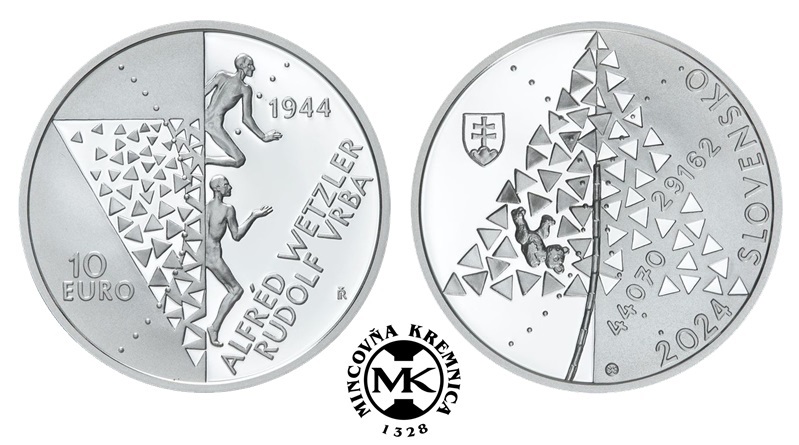New silver collector coins honour 80th anniversary of the historic Vrba –
It was during the summer of 1944 when the world became aware of the Holocaust thanks to two young men – Rudolf Vrba and Alfréd Wetzler. The story focuses on the two prisoners in Auschwitz concentration camp and the events leading up to a line-up for roll call on the 7th April 1944. Inmate numbers 44,070 and 29,162 were missing on the day and it would not be too long until the world knew the names of these two brave men. They were the Jewish Slovaks Rudolf Vrba (1924 – 2006) and Alfréd Wetzler (1918 – 1988). They did not escape to save their own lives, but instead they wanted to tell the world about what was happening in Auschwitz. Both were convinced that the governments of democratic nations would not simply stand by and watch as thousands of people were gassed to death.
Rudolf Vrba worked as registrar in the camp and from his workplace he could see where all the trains arrived every day. He diligently counted them, memorised the exact number of carriages that transported all those to Auschwitz who were murdered in the gas chambers between April 1942 and April 1944. With this piece of explosive information in mind, he planned his escape together with Alfréd Wetzler. It was an indescribably dangerous plan, and they succeeded only because they were helped by both fellow prisoners and Polish citizens. On the 21st April 1944, they crossed the border to Slovakia and when they arrived in Žilina, they found support in the Slovak Jewish Council. The two men dictated what they had seen to a stenographer, who completed the report in Slovakian on the 27th April 1944. While the report was still being written, one member of the Slovak Jewish Council began to translate it into German and another into Hungarian. At this time, the Slovak Jewish Council immediately began distributing the report to people they hoped would help. However, it was not until an official in Romania’s embassy smuggled the report into Switzerland that it received the attention it deserved. At the time, Switzerland was one of the few European countries not subject to censorship.
A Swiss student organisation made copies of the report and distributed them and between the 23rd June and the 11th July 1944, over 38 articles were published in Swiss newspapers, and the international press picked up the story. After the summer of 1944, no one could pretend not to know what was happening in the concentration camps and everyone knew the fate of those leaving Budapest on those long trains bound for Auschwitz since the 15th May 1944. By this time, it was estimated there were 700,000 Jews in Hungary and to save them, leaders from all over the world made urgent appeals to Miklós Horthy, regent of the Kingdom of Hungary. To strengthen their resolve, the appeals and demands were reinforced by leaflets stating that anyone responsible for the deportations would be held accountable for their actions. They were dropped by Allied bombers over Budapest and on the 9th July 1944, while the Allies were gaining a foothold in Normandy, Horthy gave the order to stop the transports to Auschwitz. By this time, 437,000 Jews had already been deported to Auschwitz with almost all having died in the gas chambers. However, the courageous actions of Rudolf Vrba and Alfréd Wetzler are credited with having saved the lives of nearly 200,000 Jews.

The proof and BU quality coins are produced by the Kremnica Mint at their facilities in Kremnica on behalf of the National Bank of Slovakia and designed by artist Ivan Řehák. The obverse side depicts two stylised male figures, representing Vrba and Wetzler escaping from prison toward the right side. The design is divided in two with the left half depicting a collage of triangle shapes representing the prisoners in the camp and a curved line of dots representing the guard posts. The year 1944 is placed on the upper right half with diagonal text of the names ALFRÉD WETZLER and RUDOLF VRBA placed to the lower right. To the lower left is the coin’s denomination 10 EURO and shown in the lower right near the rim are the stylised initials IŘ referring to the coin’s designer Ivan Řehák. The reverse side features a large triangle together with a collection of smaller triangles within the shape representing the camp’s prisoners. Emerging from the bottom half and positioned in the middle is a cartographic representation of railway cars. To the lower left within the large triangle is a child’s teddy bear symbolising the personal effects of the camp victims. On the right side partly overlying the triangle, are the diagonal prisoner numbers 44070 and 29162 assigned to Alfréd Wetzler and Rudolf Vrba. Each half features a semicircle of raised dots representing the camp’s guard posts. Also included is the…
Read More: New silver collector coins honour 80th anniversary of the historic Vrba –

